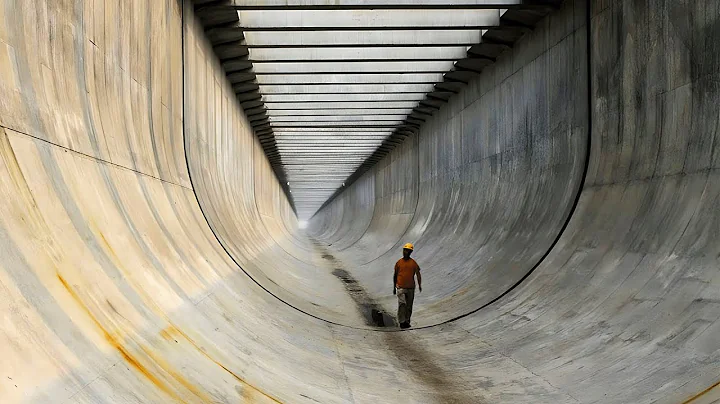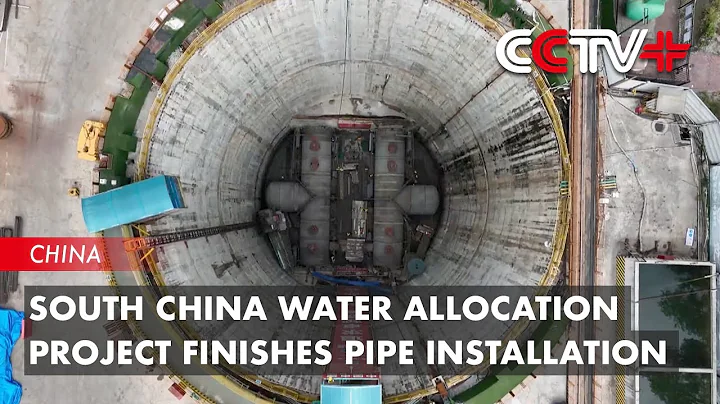On January 30th, as the water intake gate of the Xijiang Pumping Station located in Shunde, Foshan, was slowly lifted, the Liyuzhou, Gaoxinsha, and Luotian pumping stations, as important parts of the Pearl River Delta Water Resources Allocation Project, started operating. The water from the Xijiang River, flowing through underground water tunnels, entered reservoirs along the way, marking the start of the first operating period of the project.
It is reported that the total length of the water transmission line in the project is 113.2 kilometers, with an annual water supply capacity of 1.708 billion cubic meters, costing a total investment of around 35.4 billion yuan. It starts from the mainstream of the Xijiang River at Liyuzhou in Foshan's Shunde district and extends eastward to the Gongming Reservoir in Shenzhen. Consisting of one main line, two branch lines, three pumping stations, and four regulating reservoirs, it traverses the core urban agglomeration of the GBA through underground water tunnels.
The water supply will benefit more than 32 million people, meeting the water demand for production and daily use in Guangzhou, Shenzhen, and Dongguan, while providing emergency backup water sources for Hong Kong and other cities. It will gradually restore the ecological water in the Dongjiang drainage basin, further ensuring the water supply and ecological security of the GBA.

Address the uneven disution of water resourcetribs
As one of the provinces with the most abundant precipitation in China, Guangdong, however, faces the challenge of uneven distribution of water resources. The per capita water resources in Guangdong are far below the national average, while 80% of the rainfall is concentrated in the flood seAson, leading to drought and water shortage in certain areas.
Correspondingly, the rapid economic and social development in the region has increased the demand and pressure on water resources. Specifically, in the Greater Bay Area, 68% of the permanent population and 74% of the total economy rely on the water resources of the eastern Pearl River Delta, which take up only 43% of the province's total.
The water resources derived from the Dongjiang River are insufficient to sustain the future development of the Pearl River Delta. But how to address the roots of water shortage in the Dongjiang drainage basin? Since the quantity of water resources in the Xijiang River is around 10 times that of the Dongjiang River, with an exploitation and utilization rate of merely 1.3%, the best solution is to divert water from the Xijiang River to relieve the "thirst" of the Dongjiang River.
From the proposal of the initial concept of "diverting water from the west to the east" in 2005, to the start of comprehensive construction in 2019, the entire preparatory work lasted for 14 years. After extensive efforts including on-site surveys, economic analysis, stability assessment and expert reviews, a "giant dragon" stretching over 113 kilometers across the heartland of the GBA was finally decided upon as the ultimate water transmission route.
How is the water diversion achieved
It poses great challenges to engineering as the Pearl River Delta region is densely covered with rivers and road networks with numerous underground faults and complex geographical conditions. However, utilizing the method of deep shield tunneling, the project has managed to traverse 4 high-speed rail sections, 8 subway sections, 12 highway sections, and 16 sections of rivers, lakes, and seas, while reserving shallow underground spaces for multiple municipal projects. Nevertheless, numerous world-class challenges still occurred to bother the deep-buried "giant dragon".
"In the underground space with an average depth of 40 to 60 meters, the maximum water pressure in the transmission tunnel would be 1.3 MPa, equaling the weight of 2600 people standing on one square meter at the same time. The need to withstand this pressure poses great challenges to the design," said Du Canyang, the manager of a water supply company. To tackle this problem, the project adopted the technique of cast-in-place non-bonded prestressed concrete.
In the 28-kilometer section from the Gaoxinsha Reservoir to the Shaxi elevated water tank, a 6.4-meter diameter reinforced concrete pipe was cast in place. If it is still not enough to withstand the water pressure, the concrete would be tied up with steel wires every 50 centimeters to add prestress. "The large-scale use of cast-in-place non-bonded prestressed technology is rarely seen worldwide. We have created the world's longest prestressed lining water transmission tunnel," said Du Canyang.
"During the construction process, the constructors have overcome multiple challenges, breaking three world records as they created the shield tunnel with the highest water transmission pressure in the world, the longest prestressed lining water transmission tunnel in the world, and the longest pressurized water diversion project in the world," said Zhu Zhaorong.

Improving people's livelihoods and prospering the cities
"According to recent tests, the water quality of the Xijiang River has remained in the II standards for almost the entire year, equivalent to the quality of drinking water," Du Canyang told the reporter. Currently, the Huangge Water Plant in Nansha District is under testing, allowing residents of Nansha to drink fresh water from the Xijiang River. The water intake in Panyu District is under construction, and its residents will also be able to drink water from the Xijiang River in two to three years. The Songshanhu Water Plant in Dongguan, which treats 1.1 million tons of water per day, is also testing the water supplied from the Xijiang River.
The race between economic development and water demand has come to an end. "What does it mean to have an annual water supply capacity of 1.7 billion cubic meters? Think about it, the annual water consumption of Shenzhen is around 2.1 billion cubic meters, and our water supply capacity is capable of supplying such a large city," said Du Canyang.
"The arrival of the water from the Xijiang River has also accelerated the ecological water return to the Dongjiang River. Dongguan and Shenzhen have already formulated plans for ecological water return," Du Canyang added. In his view, the Xijiang River has a vast potential for exploitation with its annual average runoff of around 230 billion cubic meters, about one-fifth of the Yangtze River and five times that of the Yellow River. It not only serves as the "economic water" that drives development, but also the "ecological water" promoting the construction of a green and beautiful eco-friendly Guangdong.
Source: Yangcheng Evening News
“湾区巨龙”润岭南,创多项世界之“最”
1月30日上午11时许,位于佛山顺德鲤鱼洲岛上的西江取水闸口缓缓升起,珠江三角洲水资源配置工程鲤鱼洲、高新沙、罗田三大泵站同步启动运转,汩汩西江水经由深埋地下的输水隧洞,流入高新沙、罗田、公明等沿线水库,标志着该工程实现全线正式通水,进入初期运行阶段。
记者在现场获悉,该工程输水线路全长113.2公里,总投资约354亿元,年供水量17.08亿立方米,西起西江干流佛山顺德鲤鱼洲,东至深圳公明水库,由一条干线、两条分干线、一条支线、三座泵站和四座调蓄水库组成,以地下深层输水隧洞形式穿越粤港澳大湾区核心城市群。
此次通水将惠及超过3200万人口,系统解决广州、深圳、东莞生产生活用水问题,为香港等地提供应急备用水源,可逐步退还东江流域生态用水,进一步保障粤港澳大湾区供水安全、生态安全。

为何引?水资源时空分布不均匀
广东是全国降水量最为充沛的省份之一,但也面临着水资源时空分布不均问题,人均水资源量远低于全国平均水平,且80%的降雨集中在汛期,局部区域干旱缺水问题仍未得到有效解决。
与之对应的是,当地经济社会的快速发展,更加剧了对水资源的需求和压力。具体到粤港澳大湾区,珠三角东部以43%水资源支撑68%的常住人口和74%的经济总量。
要支撑珠三角未来发展,仅靠东江水已难以为继。如何从根本上解决东江流域缺水问题?在西江流域,其水资源量大约是东江的10倍,水资源开发利用率只有1.3%左右,谋划引西江之水解东江之“渴”,成为解决粤港澳大湾区东部城市群缺水难题的最佳途径。
从2005年提出“西水东调”的初步构想,到2010年启动“西水东调”工程前期工作,再到2019年工程全面开工建设,整个准备调研工作长达14年。经过漫长而深入的实地勘察、经济分析、维稳评估、专家评审等多方面努力后,一条全长113余公里、穿越湾区腹地的“湾区巨龙”跃然纸上,成为最终敲定的输水线路方案。

如何引?攻克多项世界级难题
珠三角地区地上河网密布、路网交错,地下断层纷繁、地质多变,对工程建设考验极大、要求极高。记者了解到,工程以深埋盾构方式,穿越高铁4处、穿越地铁8处、穿越高速公路12处、穿越江河湖海16处,并为地铁、通信、电力、管廊等市政建设预留浅层地下空间。然而,深埋盾构的“湾区巨龙”,却给工程设计、建设、运营带来诸多世界级难题。
“在平均纵深40米到60米的地下空间,输水隧洞设计最大内水压力1.3MPa,相当于2600个人同时站在一平方米的地方,由于要考虑对抗这个力量,设计就很难。” 广东粤海珠三角供水有限公司总经理杜灿阳说,工程后来通过采用现浇无粘结预应力混凝土技术来解决这个问题。
记者了解到,从高新沙水库到沙溪高位水池的28公里工程段,现浇6.4米内径的钢筋混凝土管道,如果钢筋混凝土仍然不足以抵御这么强的水压,就要再增加一个预应力,每50厘米用钢丝绳把混凝土捆起来、加大应力。“本身现浇无粘结预应力技术的大规模使用在全世界范围内都是少见的,我们创造了全世界最长的预应力衬砌输水隧洞。”杜灿阳说。
“建设过程中,建设者攻克了长距离深埋盾构施工、高水压预应力衬砌设计施工、大流量宽扬程变速水泵研发、从狮子洋岸边水平定向勘探取芯等难题,创造了三个世界之最——世界上输水压力最高的盾构隧洞、世界上最长的预应力衬砌输水隧洞、世界上流量最大的长距离有压调水工程。”朱朝荣说。

有何效?以水兴城惠民生
“我们最近进行了检验,整个西江水质基本全年能达到Ⅱ类标准,是饮用水级别的。”杜灿阳告诉记者,目前,位于南沙区的黄阁水厂已在调试,南沙区的居民可以喝上新鲜的西江水;番禺区分水口正在建设当中,两三年后就能让当地居民也喝上西江水;在东莞建设的每日处理110万吨水的松山湖水厂,输送来的西江水也在调试中。
经济发展与供水需求的赛跑也告一段落。“年供水量17亿立方米意味着什么?整个深圳一年的用水量大约是21亿立方米,我们的供水量就接近供给这样一座特大型城市。”杜灿阳表示。
“实际上,西江水的到来,也加速了对东江的生态退水,东莞、深圳都已经制定了这个生态退水的方案。”在杜灿阳看来,西江年平均径流总量约2300亿立方米,约为长江的五分之一、黄河的五倍,有非常广阔的挖掘潜能,不仅是带来发展新动能的“经济水”,更是推动绿美广东生态建设的“生态水”。
文丨记者 许张超 胡彦 通讯员 粤水轩
图丨通讯员提供
翻译丨洪婷





















